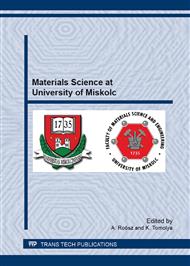[1]
Y. Tokiwa, B. P. Calabia, Biodegradability and biodegradation of poly(lactide), Appl. Microbiol. Biotechnol. 72 (2006) 244-251.
DOI: 10.1007/s00253-006-0488-1
Google Scholar
[2]
Q. Zhou, M. Xanthos, Nanoclay and crystallinity effects on the hydrolytic degradation of polylactides, Pol. Degr. Stab. 93 (2008) 1450-1459.
DOI: 10.1016/j.polymdegradstab.2008.05.014
Google Scholar
[3]
Y. Tokiwa, B. P. Calabia, C. U. Ugwu, S. Aiba, Biodegradability of plastics, Int. J. Mol. Sci. 10 (2009) 3722-3742.
DOI: 10.3390/ijms10093722
Google Scholar
[4]
A. P. Mathew, K. Oksman, M. Sain, The effect of morphology and chemical characteristics of cellulose reinforcements on the crystallinity of polylactic acid, J. Appl. Pol. Sci. 101 (2006) 300-310.
DOI: 10.1002/app.23346
Google Scholar
[5]
I. Grizzi, H. Garreau, S. Li, M. Vert, Hydrolytic degradation of devices based on poly(DL-lactic acid) size dependence, Biomaterials 16 (1995) 305-311.
DOI: 10.1016/0142-9612(95)93258-f
Google Scholar
[6]
H. Tsuji, Y. Ikada, Properties and morphology of poly(L-lactide). 4. Effects of structural parameters on long-term hydrolysis of poly(L-lactide) in phosphate-buffered solution. Pol. Degr. Stab. 67 (2000) 179-189.
DOI: 10.1016/s0141-3910(99)00111-1
Google Scholar
[7]
H. Chye, J. Loo, C. Ooi, S. Wee, Y. Chiang, F. Boey, Effect of isothermal annealing on the hydrolytic degradation rate of poly(lactide-co-glycolide) (PLGA), Biomaterials 26 (2005) 2827-2833.
DOI: 10.1016/j.biomaterials.2004.08.031
Google Scholar
[8]
S. Hurrel, R.E. Cameron, The effect of initial polymer morphology on the degradation and drug release from polyglycolide, Biomaterials 23 (2002) 2401-2409.
DOI: 10.1016/s0142-9612(01)00376-3
Google Scholar
[9]
G. Schliecker, C. Schmidt, S. Fuchs, R. Wombacher, T. Kissel, Hydrolytic degradation of poly(lactide-co-glicolide) films: effect of oligomers on degradation rate and crystallinity, Int. J. of Pharmaceutics 266 (2003) 39-49.
DOI: 10.1016/s0378-5173(03)00379-x
Google Scholar
[10]
M. Hakkarainen, Aliphatic and biotic degradation and degradation products, Adv. Pol. Sci. 157 (2002) 113-138.
Google Scholar
[11]
H. Cai, V. Dave, R. A. Gross, S. P. McCarthy, Effect of physical aging, crystallinity, and orientation on the enzymatic degradation of poly(lactic acid), J. Pol. Sci. Part B: Pol. Physics (34 (1996) 2701-2708.
DOI: 10.1002/(sici)1099-0488(19961130)34:16<2701::aid-polb2>3.0.co;2-s
Google Scholar
[12]
R. T. MacDonald, S. P. McCarthy, R. A. Gross, Ezymatic degradability of poly(lactide): Effects of chain stereochemistry and material crystallinity, Macromolecules 29 (1996) 7356-7361.
DOI: 10.1021/ma960513j
Google Scholar
[13]
M. S. Reeve, S. P. McCarthy, M. J. Downey, R. A. Gross, Polylactide stereochemistry: Effect on enzymatic degradability, Macromolecules 27 (1994) 825-831.
DOI: 10.1021/ma00081a030
Google Scholar
[14]
Effect of Polymer Stereochemistry and Crystallinity on its Enzymatic Degradability, Biocatalysis & Bioprocessing, www. poly-edu/grossbiocat/research/research023. htm. (2012).
Google Scholar
[15]
F. Alexis, Factors affecting the degradation and drug-release mechanism of poly(lactic acid) and poly[(lactic acid)-co-(glycolic acid)], J. Appl. Pol. Sci. 97 (2005) 2014-(2025).
DOI: 10.1002/pi.1697
Google Scholar
[16]
Y. Kong, J. N. Hay, The measurement of the crystallinity of polymers by DSC, Polymer 43 (2002) 3873-3878.
DOI: 10.1016/s0032-3861(02)00235-5
Google Scholar
[17]
M. Pyda, R. C. Bopp, B. Wunderlick, Heat capacity of poly(lactic acid), J. Chem. Thermodynamics 36 (2004) 731-742.
DOI: 10.1016/j.jct.2004.05.003
Google Scholar
[18]
X. Ling, Thermal and X-ray Analysis on the Origin of Double Melting Phenomena of Poly(L-lactic Acid) Films, PhD dissertation, (2005).
Google Scholar
[19]
S. -L. Yang, Z. - H. Wu, W. Yang, M. -B. Yang, Thermal and mechanical properties of chemical crosslinked polylactide (PLA), Polymer Testing 27 (2008) 957-963.
DOI: 10.1016/j.polymertesting.2008.08.009
Google Scholar
[20]
R. Al-Itry, K. Lamnawar, A. Maazouz, Improvement of thermal stability, rheological and mechanical properties of PLA, PBAT and their blends by reactive extrusion with functionalized epoxy, Pol. Degr. and Stab. 97 (2012) 1898-(1914).
DOI: 10.1016/j.polymdegradstab.2012.06.028
Google Scholar
[21]
A. J. Domb, J. Kost, D. M. Wiseman, Handbook of Biodegradable Polymers. Overseas Publishers Association, CRC Press, Amsterdam, (1997).
Google Scholar
[22]
A. Delgado, E. Carmen, M. Llabres, Degradation of DL-PLA-methadone microspheres during in vitro release, 140 (1996) 219-227.
DOI: 10.1016/0378-5173(96)04606-6
Google Scholar


